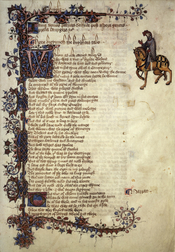The fabliaux, "The Reeve's Tale" and "The Miller's Tale" of Geoffrey Chaucer's The Canterbury Tales, express similar characteristics yet simultaneously express differences. "The Reeve's Tale" is far more perverse than "The Miller's Tale", which is expressed as a story of slapstick humor and ignorance. Both "The Reeve's Tale" and "The Miller's Tale" coincide on the topic of deception. Both of these tales express the theme of revenge. "The Reeve's Tale" concentrates on the theme of sin more than "The Miller's Tale" does. Both "The Reeve's Tale" and "The Miller's Tale" possess the common topic of lust. Both these fabliaux manifest their narrator's motive for reciting these tales. Nevertheless, the clear victor between the conflict of the reeve and the Miller would obviously be the Reeve.
"The Reeve's Tale" mainly deals with sex, burglary, and cruelty which allow one to describe it as a "black" comedy.
"The Reeve's Tale" dealt with a sinister Miller named Simpkin, who stole wheat and corn. The narrator explains, "He was a thief as well of corn and meal, and sly at that; his habit was to steal" (109). Simpkin is a notorious brute who is married to a daughter of a parson. They have a 20 year old daughter named Molly and an infant. The Miller planned to steal meal from the two students, Alan and John. Knowing of the Miller's trick, they planned to take revenge by fornicating with the Miller's daughter and wife. The Miller's Tale is different in the sense that the narrator speaks of an old carpenter as being gullible and unaware of his surroundings. The Miller marries a young woman, who ends up being seduced by...


